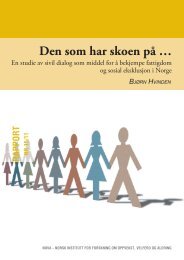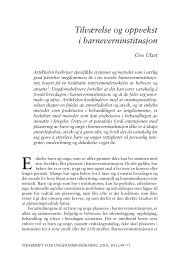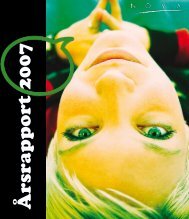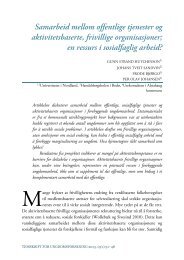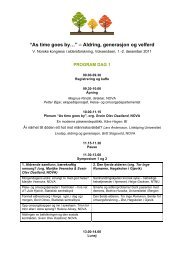Parents' socioeconomic status and children's academic ... - Nova
Parents' socioeconomic status and children's academic ... - Nova
Parents' socioeconomic status and children's academic ... - Nova
You also want an ePaper? Increase the reach of your titles
YUMPU automatically turns print PDFs into web optimized ePapers that Google loves.
esource person; (s)he may also be a person who provokes stress <strong>and</strong><br />
antipathy on the part of the youngsters in the family. Stepfathers, stepmothers,<br />
<strong>and</strong> the stepchildren’s attitudes <strong>and</strong> reaction towards them vary<br />
considerably. Hence, it is not possible to determine a priori exactly how<br />
school results vary between family types. However, this is a topic worth<br />
analyzing empirically (Lauglo 2008).<br />
Children of immigrant background are in some studies found to<br />
achieve somewhat lower grades than native Norwegians do. In the group of<br />
non-western immigrants, we also find lower educational levels, lower labour<br />
market participation <strong>and</strong> lower economic <strong>status</strong>. For example, in the present<br />
project Tormod Øia <strong>and</strong> others found that immigrants in the low- income<br />
sample have lower income <strong>and</strong> living st<strong>and</strong>ards than low income Norwegians<br />
(Øia et al. 2006). An important question to settle is therefore whether any<br />
differences in school outcomes of native Norwegians <strong>and</strong> children from<br />
immigrant families can be explained by stronger exposures to risk connected<br />
to parental education <strong>and</strong> labour market participation.<br />
Numerous empirical studies have shown low educational achievement<br />
among ethnic minorities. For example, Bakken (2008) in his study of<br />
minority students at lower <strong>and</strong> upper secondary school found that students<br />
with a minority background achieved lower result than those with a nonminority<br />
background.<br />
Another example concerns variation in recruitment to higher education,<br />
where there is clear variation between non-western immigrants <strong>and</strong> native<br />
Norwegian youth. Yet this variation diminishes when social class is controlled<br />
for (Dæhlen 2001). Moreover, a British study shows that non-western<br />
immigrants are not underrepresented in recruitment to higher education, <strong>and</strong><br />
their share (except the Caribbean) has increased since 1990 (Modood 2004).<br />
Lucinda Platt found that first generation migrants with solid cultural capital<br />
face social degradation, but that they reassert their social background in their<br />
second generation, while those with low cultural capital (labour class) remain<br />
in the same social class in their second generation (Platt 2005a).<br />
Children are often assumed to benefit from parental participation in the<br />
labour market. The argument is that labour market participation provides<br />
economic resources <strong>and</strong> stability. It may also yield access to networks<br />
– Parents’ <strong>socioeconomic</strong> <strong>status</strong> <strong>and</strong> children’s <strong>academic</strong> performance – 13




